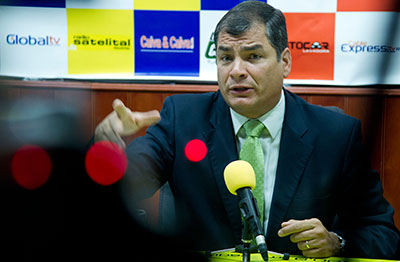On September 11, 2012, the Ecuadoran government interrupted a morning newscast on the Teleamazonas TV station for an official bulletin. What could be so urgent? A coup d’etat? An earthquake? A cholera outbreak?
It turned out the government sought to clarify what President Rafael Correa had for breakfast.
In this series
• Part 1: Repression deepens
• Part 2: Breakfast bulletin
• Part 3: Election without news
• Part 4: Four more years
The issue arose a week earlier on Teleamazonas when an opposition lawmaker claimed that during Correa’s visit to a provincial town where he ate breakfast in a local market, the president’s food had actually been provided by a nearby hotel. It wasn’t exactly “breakfast-gate.” Yet the secretary of communications put together a three-minute rebuttal complete with interviews of market vendors who confirmed that they had prepared the empanadas and coffee that Correa had consumed.
Under Ecuador’s 2008 Constitution, which guarantees the “right to reply” to those who maintain they were slandered by the media, Teleamazonas, a private station that’s often critical of the government, had no choice but to broadcast the segment.
The practice of pre-empting broadcasts for official announcements, known as cadenas, was enshrined in Ecuador’s radio and television law in 1974, under a military government. Back then, the state did not own any TV stations and the provision was designed to guarantee air time for important government announcements and communiqués in times of crisis, according to César Ricaurte, director of the Andean Foundation for the Observation and Study of the Media, or Fundamedios.
Until recently, the measure was used sparingly, according to Alfonso Espinosa, an anchor for the private Ecuavisa TV station, who has worked as a journalist for 46 years. By contrast, Espinosa told CPJ, the Correa administration is using cadenas as a habitual tool to bully its way onto the air, respond to critics over issues great and small, and flood the airwaves with propaganda.
From January 2007 when Correa was first sworn in to August 2012, his government broadcast 1,365 cadenas for a total of 11,793 minutes, according to Fundamedios. That adds up to more than eight days of airtime.
Fundamedios, which has been critical of the Correa government’s crackdown on the press, has itself been the subject of 10 cadenas, Ricaurte said. Just in the past year, Teleamazonas has been forced to broadcast 69 hours of government cadenas.
Some of the segments pre-empt programming nationwide to transmit news about government activities. But others serve as rebuttals to specific news reports and interviews touching on Correa and his ministers. In these cases, the secretary of communications often informs the station the day before that it must broadcast the government’s reply at a specific time with no advance warning of its content.
“There is no way to prepare for a cadena because you have no idea what the government is angry about,” said Janet Hinostroza, who anchors the “30 Plus” newsmagazine on Teleamazonas and whose reports have prompted several cadenas. “You get surprised on the air.”
Ricaurte, of Fundamedios, calls the cadenas especially abusive because the government has so many other ways to get its point across. For one, it spends huge sums on advertising. For another, the government has built up a public media empire consisting of 21 outlets, including newspapers, TV, and radio stations that often reflect the administration’s point of view. In addition, journalists constantly seek interviews with administration officials. But claiming they are biased, Correa has ordered his ministers and many other appointees not to speak to media outlets critical of his government.
Patricio Barriga, Ecuador’s acting secretary of communications, told CPJ that many of the cadenas are educational in nature. He said these segments are necessary because private TV stations, which have the highest audience ratings, focus on entertainment and don’t do enough to educate and inform the public.
The pre-recorded rebuttals, Barriga said, are designed to counter what he claims have been a barrage of lies about the government told by the private media. The government stopped providing officials for their interview programs, Barriga said, because they were nearly always used to provide a semblance of balance for reports that were slanted against Correa.
When asked why the Correa government found it necessary to use far more cadenas than any government in Ecuadoran history, Barriga said: “The law is the law, and if the law permits it, it will be used.”
Although the cadenas are a nuisance, especially when they eat into prime time, Ecuadoran TV executives say they are just one of several ways the Correa government is trying to undermine their stations.
For example, a ballot measure approved in 2011 states that the owners of media companies must divest themselves of other businesses. The measure was ostensibly designed to prevent conflicts of interest in news reporting. However, critics contend it could make media companies more reliant on government advertising–and less critical–since their owners can no longer rely on outside business profits to help prop up struggling newspapers, TV, or radio stations.
There’s also a brewing fight over content. After years of broadcasting soccer games, Teleamazonas and Ecuavisa recently lost their rights to Ecuadoran matches–a massive audience draw–when the Ecuadoran Soccer Federation signed a lucrative new deal with public TV. In both cases, according to executives for Teleamazonas and Ecuavisa, the government’s bid far outstripped what they could offer and they suspect political motives were involved.
The government “wants to reduce the influence, the business and the ratings of private television stations,” said one TV executive who did not want to be identified. “And there are many ways to do that.”
[Reporting from Quito, Ecuador]
